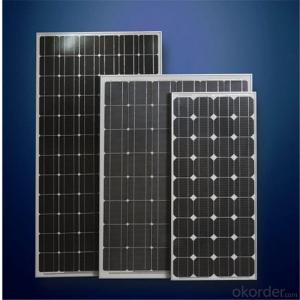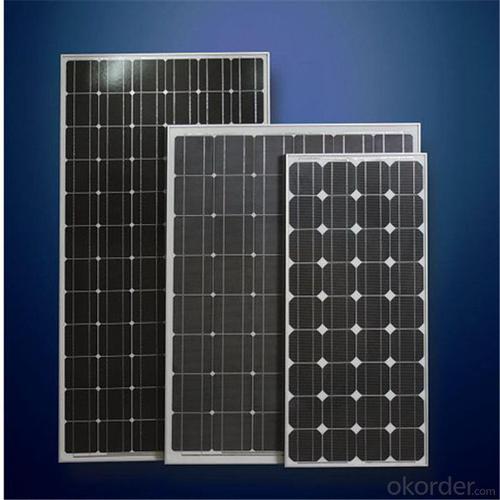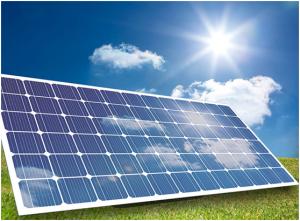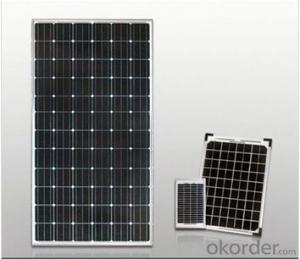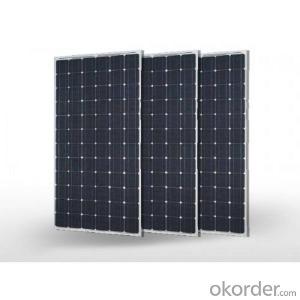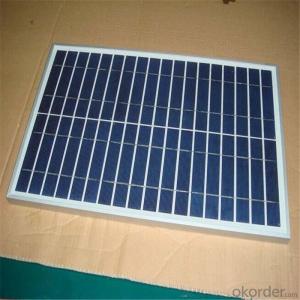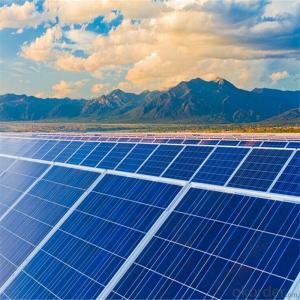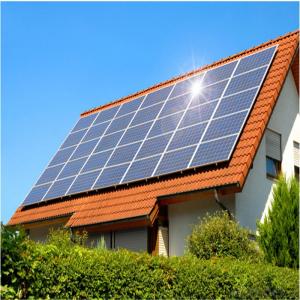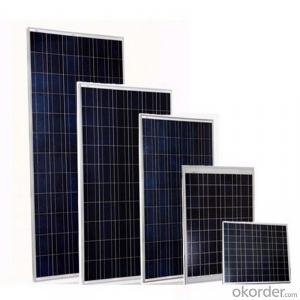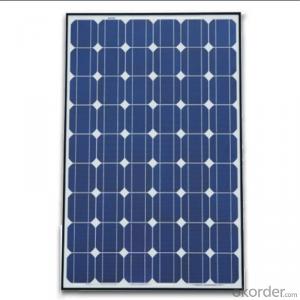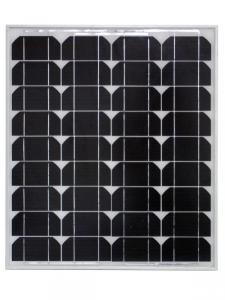240w 60 Cell Solar Photovoltaic Module Solar Panels for Mojave Desert
- Loading Port:
- China main port
- Payment Terms:
- TT OR LC
- Min Order Qty:
- 1000 watt
- Supply Capability:
- 500000 watt/month
OKorder Service Pledge
OKorder Financial Service
You Might Also Like
Specification
Instruction
1) Product name: solar panel / module
2) Solar cell: Mono-crystalline / Poly-crystalline / Amorphous
3) Tempered glass laminated with aluminum frame
4) Life time: 20 - 25 years
5) Temperature co-efficiency: A=+1,46mA B=-79mV, Rp/p=-0.43
6) Power specification at 1kW/m 2, AM 1, 5
7) Output cable: multi contact connectors
8) Construction:
a) Front: High-transmission 32mm tempered glass
b) Back: TPT
c) Encapsulant: EVA
9) Frame: aluminum
10) Certification: CE, TUV
Feature
1. Nominal 18V DC for standard output.
2. Cable connectors for easy installation.
3. Outstanding low-light performance.
4. Splendid aesthetic appearance and easy installation.
5. High efficiency & high stability.
6.Advanced EVA encapsulation system with TPT back sheet to improve product modules
7. Design to meet unique demand of customer.
8.25 year module output warranty.
9. Rugged design to withstands high wind pressure and snow load, easy installation.
10. Designed to comply with rigorous operating conditions, including test.
Images
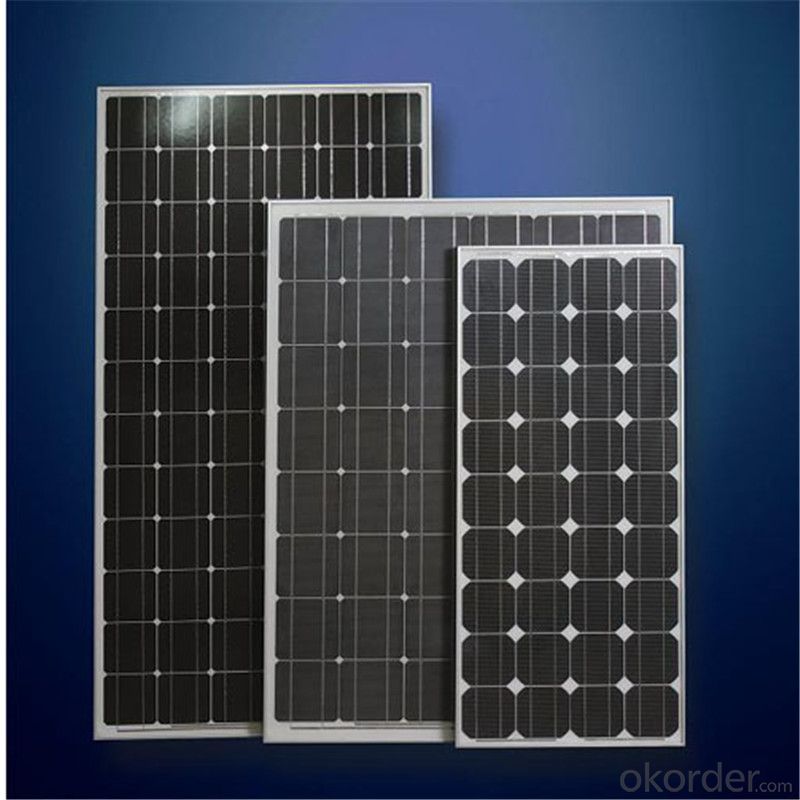
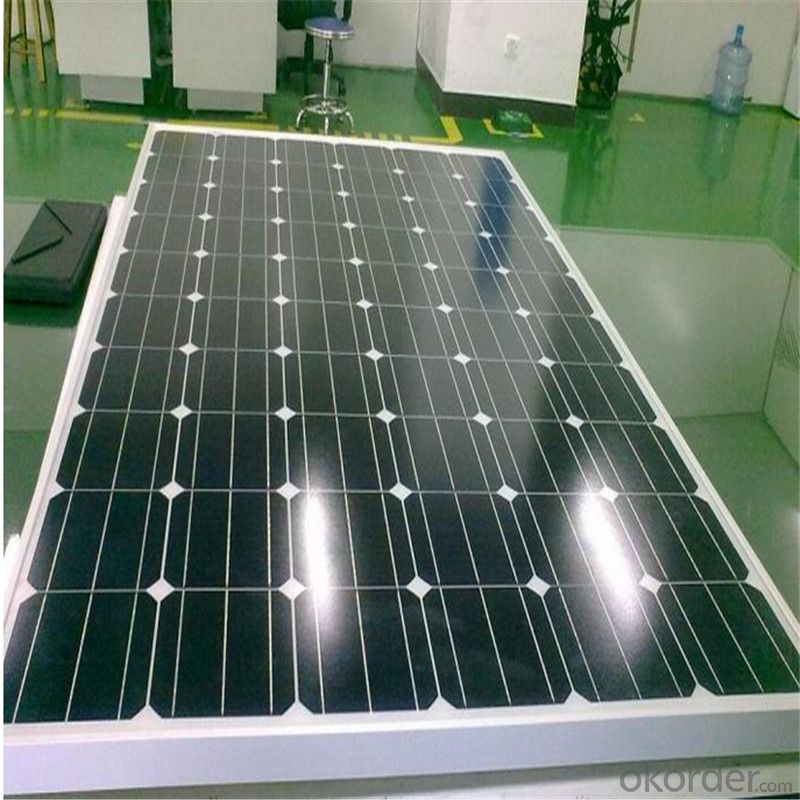
Specification
Dimension (mm) | 1640*992*40 |
NO of Cells and Connections | 60(6x10) |
Weight(kg) | 18.5 |
Tolerance | 0~+5% |
Cell | Polycrystalline Cell 156 x 156 mm |
Operating Temperature | –40 °C to +85°C |
Max System Voltage(VDC) | 1000 |
Packing | 312PCS/20ft(H) Container |
FAQ
We have organized several common questions for our clients,may help you sincerely:
1). What’s price per watt?
A: It’s depends on the quantity, delivery date and payment terms of the order. We can talk further about the detail price issue. Our products is high quality with lower price level.
2). Can you tell me the parameter of your solar panels?
We have different series of cells with different power output, both from c-si to a-si. Please take our specification sheet for your reference.
3). How do you pack your products?
We have rich experience on how to pack the panels to make sure the safety on shipment when it arrives at the destination.
4). How long can we receive the product after purchase?
In the purchase of product within three working days, We will arrange the factory delivery as soon as possible. The perfect time of receiving is related to the state and position of customers. Commonly 7 to 10 working days can be served.
- Q: What is the difference b/w them which one is better .
- these solar panels are named different based on the solar cells used... mono-crystalline solar cells: As the name suggests, each cell is made from a slice of a silicon crystal, which is made by purifying, melting and freezing silicon. pol-crystalline solar cells: these are a slight variation of single crystal solar cells. they are made of slices cut out of blocks of several silicon crystals, as opposed to single silicon crystals. check the link below to see other differences between the two types (easy to understand), such as their prices and efficiency levels. there is also a third type of solar cell/panel called amorphous solar cells.
- Q: What is the average lifespan of a solar panel?
- The average lifespan of a solar panel is typically around 25 to 30 years.
- Q: Can solar panels be used on agricultural land?
- Yes, solar panels can be used on agricultural land. In fact, solar installations on farms and agricultural areas have become increasingly popular due to the dual benefits they offer. They not only generate clean energy but also provide farmers with an additional revenue stream. By utilizing solar panels on their land, farmers can offset their energy costs, reduce their carbon footprint, and contribute to a more sustainable future.
- Q: i don't know very much about it, but can you somehow take off the little solar panels off of the outdoor light things and make it so you can hook an outlet up to it and plug in to it like a phone charger for electricity.
- Little solar panels on lights are very low power. The battery in one such may be 0.5 Amp-hours and .2 V ; it may be different but it should be marked on the panel/battery/manual. An outlet in your house is designed to run on 20 V (typically in N. Am.) and they run on alternating current (AC) whereas the panel generates direct current (DC). (If you don't know the difference, do not worry to much but just understand that they are not directly compatible.) You therefore need an inverter to change DC to AC (and lose some although inverters are now very efficient). But the amount of power generated by those panels is still very small. That is why solar lights are low power (just a few watts in most cases). To make things even more irritating, phone chargers do not work off 20 V AC as you are charging the battery and need a low voltage DC -- which is what the solar panel is giving you. It is almost certain that the voltage from the panel will be less than the voltage required for the phone. The charger is mostly cable but there is a black box incorporated and it should say what the voltage and current output are (the input will be 20V). So you should be able to overcome this not by hooking up the panel to a 20V outlet and then plugging the charger in but by hooking up the panel to the phone directly if you can get enough voltage out of the solar panel (or hook up several) and if you fashion a connection device. They already make them -- solar battery chargers and I am sure you can enter that into a search engine and find loads. Typically the panel alone is much more than a solar light -- which shows the relative power requirements.
- Q: Any recommendations for companies? Any things to look out for?
- It depends upon how you look at things. If you are looking for a decent return on investment, or a business decision, it is probably very unwise. In most cases people would see a far better return in upgrading insulation in ceilings, walls, and windows to much better insulation than they currently have, followed by proper resizing heating and air conditioning to smaller unit size to fit their lesser need as a result of the insulation. The heat an air conditioning units should be the highest efficiency available. The return on the above can make a positive and economic investment in many cases. If you have done the above first, and have money to spend and do not care about the return on it, then you can play with solar or wind. However, typical cost of generation of solar and wind energy is about $0.22 / KWH and you can purchase from utility at about $0.0/ KWH including generation and distribution so this is not all that prudent.
- Q: So I want to go completely solar. Do I need the connected solar panels alone for after sundown hours; Do I need something else in order to have energy to run my entire house throughout the night?In other words do solar panels store the energy for after sun-down or do I need other devices to store the energy?
- Solar okorder
- Q: Can solar panels be used in areas with high levels of radiofrequency interference?
- Yes, solar panels can be used in areas with high levels of radiofrequency interference. However, it is important to ensure proper grounding and shielding measures are in place to minimize the impact of radiofrequency interference on the performance of the solar panels.
- Q: Can solar panels be installed on historical buildings?
- Yes, solar panels can be installed on historical buildings. However, the installation process may require careful planning and consideration to ensure that the historical integrity and architectural significance of the building are not compromised.
- Q: My plans are building several solar panels and have a battery bank. I want to be able to power the refriderator and freezer and occationaly an electric grill. How would This work exactly and what would the best way to hook this up to make it work? I want to be able to convert DC to AC. How many batterys would I need to make this work. I know when Civil unrest happens I want to be prepared. How would Wind Power work If I can get the equipment I need?
- Solar panels and wind/water turbines all produce the energy and feed it into the batteries. Outfeed from the batteries thru an inverter to an electrical panel. From panel to outlets, into which you plug standard appliances and items. You can also get some appliances that run off of 2volt. Check with r.v. companies and suppliers for these. You can also run low voltage wires straight from batteries to switches to lights, fans, etc if you put in 2v ones. Just like your car has lights, fans (ac blower), and radio. As for how many batteries you need will depend upon how much ebergy you will use. You will need to figure how much all of your items use per hour. Then figure how long your charging device could be down for at a time. Solar panels will not charge at all for the 8-2 hours of nightfall depending on your area. Wind turbines will charge day and night so long as wind is of sufficient speed. Water turbines will charge 24/7 so long as water source(creek, stream, river) doesn't run dry. Neccessity/hr=N, time without charging =T. N times T = the amount of backup power you need to get you thru till charging sysytem kicks back in.
Send your message to us
240w 60 Cell Solar Photovoltaic Module Solar Panels for Mojave Desert
- Loading Port:
- China main port
- Payment Terms:
- TT OR LC
- Min Order Qty:
- 1000 watt
- Supply Capability:
- 500000 watt/month
OKorder Service Pledge
OKorder Financial Service
Similar products
Hot products
Hot Searches
Related keywords
